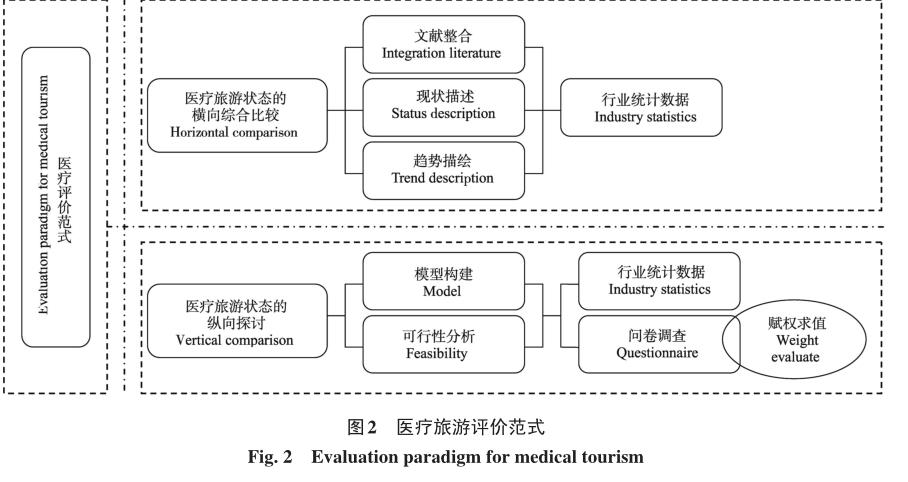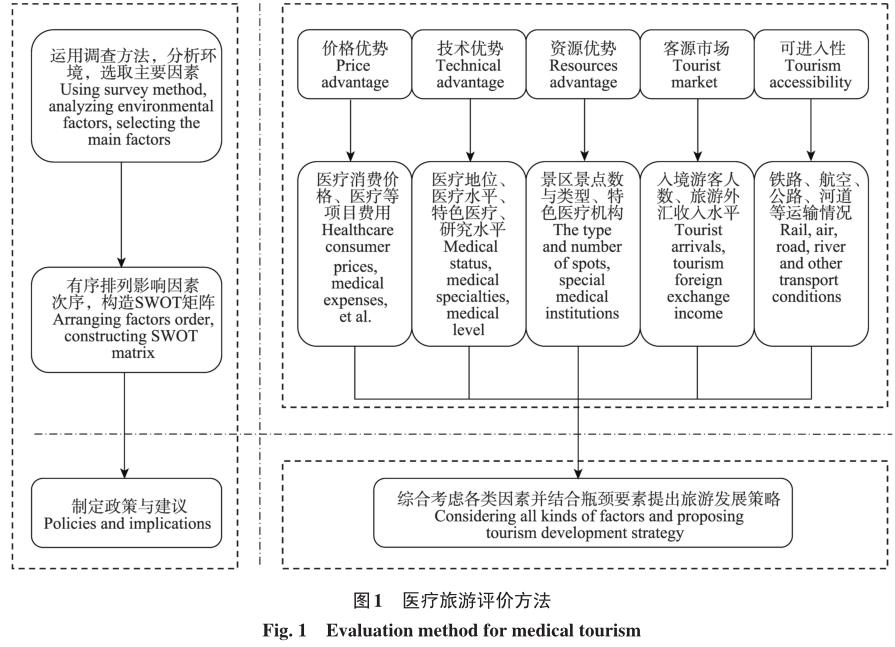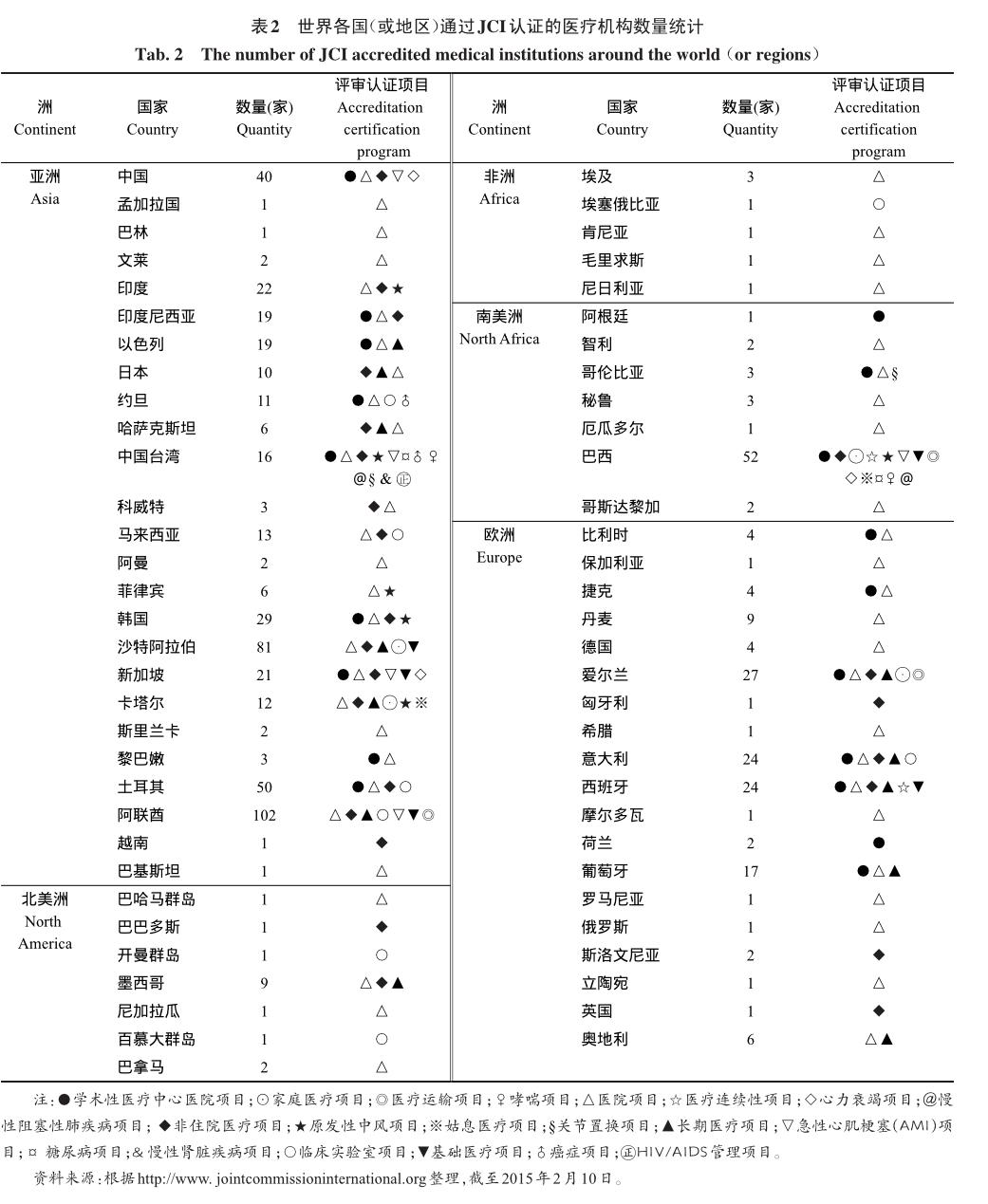医疗旅游:国内外文献的回顾与研究展望
2016-05-14刘建国张永敬
刘建国 张永敬



[摘要]随着社会经济的全面发展,旅游业已经远远超越了传统服务业的范畴,正在向战略性支柱产业和现代服务业转型升级。以追求健康为目的的医疗旅游正成为旅游业发展的新业态、新趋势。文章通过对国内外医疗旅游研究文献进行梳理,发现学者们的贡献主要集中在:医疗旅游的概念界定、医疗旅游的影响因素分析、发展医疗旅游带来的效应评价等方面,而且部分内容相对较为成熟。但从现有研究来看,普遍缺少对医疗旅游演变的影响要素、规律和机制的深入研究;从研究数据上看,现有数据较为单一,缺乏连续性的数据资料。从医疗旅游研究的不足出发,需要以学科交叉为途径,推动跨学科的集成研究。未来研究包括:研究医疗旅游的相关理论问题;解析医疗旅游的影响因素及其机理;探讨医疗旅游的静态现状和动态演变规律;剖析医疗旅游发展的动力机制及其效应;构建医疗旅游发展的政策体系等。
[关键词]医疗旅游;文献综述;研究进展
[中图分类号]F59
[文献标识码]A
[文章编号]1002-5006(2016)06-0113-10
Doi: 10.3969/j.issn.1002-5006.2016.06.017
引言
随着我国经济社会的全面发展,旅游业已经远远超越了传统服务业的范畴,正在向战略性支柱产业和现代服务业升级。为适应人民群众消费水平的提升和产业结构的调整,2014年8月22日,《国务院关于促进旅游业改革发展的若干意见》(国发〔2014〕31号)再一次把旅游业的发展提到更加重要的地位,强调要增强旅游发展动力、拓展旅游发展空间,明确提出“推进整形整容、内外科等优势医疗资源面向国内外提供医疗旅游服务。”
医疗旅游,作为旅游的高端业态,其发展引起政府和学术界的关注。2013年全球水疗与健康峰会(GSWS)与斯坦福研究机构(SRI)联合发布的全球医疗健康旅游产业经济研究报告显示,2012年全球医疗健康旅游产业规模为4386亿美元[1]。据不完全统计,2012年全球“医疗游客”人数为4000万人次,医疗旅游的人均消费达到1万美元[2]。随着人民群众对旅游多样化、多层次的消费需求不断增强,传统的观光旅游已转型升级为观光、休闲度假,乃至疗养并重的形式,医疗旅游由此将迎来新的快速发展机遇。
医疗旅游,是旅游业发展的新趋势,是以追寻健康与享受旅游服务于一体的旅游形式,它实现了医疗业和旅游业的跨界融合。该旅游形式在国际上通常被称为医疗旅游(medical tourism)、健康旅游(health tourism)、外科手术(surgery)旅游、医疗外包(medical outsourcing)等。从发展实践上来看,泰国、马来西亚和印度等国家率先对这个旅游新分支进行积极的投资并支持其发展[3-4];从研究层面来看,医疗旅游涉及的领域广泛,包括地理、生态环境、市场营销等多个层面,如基于游客需求和市场开发视角的医疗旅游划分研究[5];通过设定一个支持或者反对从事医疗旅游决策程序,以及需要注意的治疗事项,如质量、安全问题等探究医疗旅游的动机研究[6]。总之,不同领域的学者已经关注了医疗旅游的诸多议题、研究内容与方法。然而,面对医疗旅游业的蓬勃发展,以及全球医疗旅游格局的不断形成,亟需系统地梳理国内外有关医疗旅游研究的演进历程和现状,揭示其研究动态和前沿领域,这对完善医疗旅游的研究具有重要意义。
1研究方法
对医疗旅游进行研究前,首先对文献进行了检索和识别。国外的文献是通过对EBSCO、Springer Link、Sage Publications、Emerald、ScienceDirect、Web of Sciences等数据库以及Google学术搜索、百度学术检索,以“medical/tourism”“health/tourism”等为题名、主题、关键词进行检索,并对获取的学术文献逐篇甄选,最后甄选出160余篇英文文献(截至2015年3月20日)。文献类型包括期刊论文、论文集、会议论文、研究报告、学位论文以及著作章节。国内文献则是通过对中国知网(CNKI)进行检索,以“医疗旅游”“健康旅游”“保健旅游”;“医疗”并含“旅游”;“健康”并含“旅游”等为题名、主题、关键词,获得包括期刊、会议、学位论文等相关学术论文100余篇(截至2015年3月20日)。但是通过文献筛选,发现大部分该领域的国内文献可利用价值不高。故此,本综述主要基于对国外文献的梳理。本文的结构安排如下:第二部分梳理和总结了医疗旅游的定义;第三部分描述了医疗旅游的影响因素;第四部分讨论了医疗旅游的评价方法、研究范式、评价领域及其效应等;第五部分总结了医疗旅游研究的相关理论视角;最后一部分总结全文并提出了医疗旅游未来研究的可能方向。
2医疗旅游的定义研究
已有的文献表明,早期的医疗旅游(medical tourism)是从健康旅游(health tourism)中派生出来的一个新分支,它结合了旅游业和医疗业的特点。世界旅游组织将医疗旅游定义为以医疗护理、疾病与健康、康复与修养为主题的旅游服务。早在18世纪,医疗旅游兴起于欧洲上层社会,医疗旅游活动仅局限于温泉疗养。到了19世纪,以保健为目的的旅游人数不断上升,医疗旅游服务阶层也从上层精英社会向工薪阶层转移。至此,医疗旅游得到飞速发展。所谓的医疗旅游,是个人有目的地离开本地区或本国去目的地接受美容整形、外科手术(surgery)、器官移植(organ transplantation)等医疗服务并享受旅游的过程。由此可见,健康旅游比医疗旅游更加宽泛。只要与健康相关的项目都包含在内,而医疗旅游一般是指与专业治疗或体检相关的项目。
总之,国内外学者主要从游客动机、游客需求、地域跨度、医疗服务产品[17-18]等多个角度对医疗旅游的概念进行界定(表1)。而且由于医疗旅游的研究尚处于初级阶段,并没有统一、标准、科学的定义,其概念界定缺乏理论的支撑,学者们对医疗旅游概念的研究呈现多元化。医疗旅游特征主要包括几个关键因素:跨境、进行旅游的同时并含医疗[30-33]。学术界的普遍共识是不同于传统的国际观光旅游,医疗旅游呈现高品位、低价位,客流反向流动的特征,即其旅游客流主要从发达国家向发展中国家流动,并且这种现象正日益加剧。由于医疗旅游项目行程包括治病、休疗养及观光游览,所以相比观光旅游,医疗旅游在旅游地停留时间较长。此外,还有学者基于人类学和医学的视角[34-35],从医疗旅游的特殊问题和现象入手[36],来探讨医疗旅游发展趋势。医疗服务与不断上升的全球健康的不平等问题逐渐成为学者定义医疗旅游所考虑的内容之一[34,37-39]。
3医疗旅游的影响因素
3.1经济因素
从医疗旅游的兴起原因来看,主要在于人们无法负担得起在本国接受治疗的费用[7-10],而且医疗旅游的特征之一是高品质低价位。因此,医疗旅游费用是影响医疗旅游发展的主要因素之一。医疗旅游不仅包括出国就医,还包括寻求医疗旅游目的地最先进的医疗技术和最有竞争力的医疗价格[40-44],所以医疗旅游的费用便越发得到人们的关注。医疗旅游的费用研究,主要是基于游客在医疗项目上的花费这一视角,探讨目的地国家医疗旅游费用成本及其影响因素。这一领域的研究包括:一方面,医疗费用是影响游客前往国外接受治疗的重要原因[45]。如心脏瓣膜手术(heart valve surgery)、髋关节置换(hip replacement)等手术,各国的费用成本差异较大。Caroline等的研究表明,游客在加拿大进行的减肥医疗和康复项目成本受到多方面的影响[46],人均花费为16 000美元[47],合理的价格对医疗旅游的发展具有显著的促进作用[48]。Caroline等甚至认为,探究在国外与当地进行医疗服务的成本与效益将会是未来的研究方向[46]。除此之外,医疗产品的成本也是影响医疗旅游发展的重要因素之一。如泰国、马来西亚、印度、新加坡等国医疗旅游发展的实践表明,目的地国家可以在低成本的条件下,生产和客源国同样质量的医疗产品,而且目的地国家具有高技能的劳动力、较低的资本成本,以及相较于客源国而言更低的旅游花费等优势[3, 49]。另一方面,基于财政激励和制度支持的综合评判医疗旅游费用研究。由于医疗旅游费用不仅受生产条件与成本的制约,还受财政政策与制度等多重因素的影响。故此,国内外日益关注政府医疗机构,或者部门财团等官方旅游机构对健康旅游的影响与促进作用[3, 49]。一些学者关注财政、税收制度对医疗旅游的影响。如对菲律宾、马来西亚、泰国的研究表明,除了劳动力的低成本、医疗旅游基础设施建设的完善外,优惠的税收制度、从业者的保险、以及旅游景点保健中心等成为促进降低医疗费用、节约游客花费、支撑医疗旅游发展的重要因素[3, 13, 28, 50]。
3.2医疗旅游资源
医疗旅游的产生部分是由于在本国接受治疗所要等待的时间较长[11-12],或本国无法提供相关治疗[13-15],以及移民人群更愿意回祖国接受治疗[16],所以资源禀赋是影响医疗旅游发展的另一重要因素。关于医疗旅游资源的研究,学者们重点关注某一国家(某一城市)的特色医疗资源,或者某一区域医院的特色医疗项目。张广海和王佳[51]把中国的医疗旅游资源分为4类,包括:特殊气候条件、特色中药、传统中医医术及中医名家、现代高科技医疗技术的医疗旅游资源;并进一步地将我国医疗旅游分为4大功能区。在关注某一国家的旅游资源方面,主要集中在亚洲、美洲、东欧,如加拿大、菲律宾、马来西亚等在减肥(bariatric surgery)、温泉疗养(SPA)、美体(body health)等特定类型的医疗手术与服务项目的优势上[3, 13, 46, 50];关于某一区域特色医疗项目上,主要体现在对东南亚和南美地区依托现有医疗资源,提供特定类型的手术及游客旅游经历的研究[52-53]。如阿根廷的tango产品系列的整容研究所表征的:游客通过观看tango表演使其产生塑型美体的愿望,最终实现在阿根廷进行医疗服务[54]。此外,国家间的医疗合作协议、政府的医疗设备等的优惠税收政策支持,也为这些医疗机构的医疗设备达到世界先进水平提供了支持。这些举措不仅提高了本国的医疗服务标准,增加了外汇创收,而且为患者提供了可以得到及时救治的医疗资源[3, 12, 22, 55-56],从而塑造了良好的医疗服务环境与服务水平。
3.3医疗旅游需求
医疗旅游的发展尽管处于起步阶段,但却呈现出游客对医疗旅游有着更为多样性与多元化需求的态势。学界日益重视医疗游客的产品选择、产品的满意度,以及医疗旅游发展模式等对医疗旅游的影响[57]。可以认为,不同医疗游客群体的需求将影响医疗旅游的发展。当前国内外主要关注医疗旅游的产品需求[25],如探讨中国、日本和韩国的游客在医疗项目产品选择上的差异。研究结果表明,医疗旅游过程中,游客的需求表现出差异化。中国游客倾向于选择美容和医疗保健方面的产品,而日本游客则强调康复服务。另有学者探索了中国内地游客前往香港进行医疗旅游的动机,发现生二胎、为孩子获得香港居民身份,并享受其带来的教育福利和医疗保障等是中国内地游客的主要动机和需求[58]。
3.4医疗服务水平
医疗旅游通常依托一定的医学知识、医疗设施与医务人员。从国际医疗旅游产生的动因来看,服务水平是影响其发展的重要因素[27, 59]。医疗旅游服务水平,既能客观描述目的地的医疗基础设施现状及医疗旅游质量,又能揭示不同国家游客对医疗服务水平构成要素的满意度等。具体而言,医院服务能力与技术结构可由医院基础设施、医院规模与等级等反映。在世界上认可度较高的有医疗机构评审联合会(Joint Commission on Accreditation of Healthcare Organizations,JCAHO)和国际联合会(Joint Commission International,JCI)。其中,JCAHO是针对美国境内的医疗机构认证,JCI则为美国境外各国医疗机构资质进行认证。医疗机构是否属于JCI的认证项目,及其评审认证等级成为决定游客是否前往目的地的重要参考因素。通过对比各国JCI数量及其由JCI评审认证项目(表2)发现,通过JCI评审认可的医疗机构数量与地区医疗旅游发展程度存在相关性。由前面医疗旅游的定义可知,游客由于在本国的医疗成本较高或医疗资源的可获取性等因素的影响,一般是前往海外医疗机构接受治疗,这也表明一国JCI认证医疗机构的数量是影响游客选择医疗目的地国家的重要因素。此外,随着医疗旅游全球化的不断发展,医疗旅游组织者在处理游客由于语言、文化习俗、行程安排等差异化问题中的协调作用日益凸显。因此,医疗旅游组织者的作用也成为衡量医疗旅游服务水平的指标之一[60]。
3.5医疗旅游营销途径
由于现代生活方式增添了人们对营销渠道需求的多样性、复杂性,医疗旅游营销已成为全球化、信息化背景下,影响医疗旅游发展的一大重要因素。有研究发现,医疗旅游营销要综合考虑游客、商务人士、医疗旅游产品运营商和供应商等主体,既需要满足消费群体的需求和一般的营销趋势[57,61-63],又需要综合医疗旅游模式[64]。综合国内外旅游学界对医疗旅游营销的丰富研究发现:广告策略的使用在医疗旅游营销中占据重要的地位,学界对此的研究兴趣也日益增长[15, 23, 65-67]。而医疗旅游模式取决于旅游市场的决策者,如高档酒店更愿意投资建设医疗旅游[68];“医疗套餐(medical packages)”也逐渐成为医疗旅游营销中的新宠,即游客选择套餐项目,其家人可在该医疗机构的不同中心,接受医疗服务,或游客获得免费的往返机票及医疗旅游费用的减免等优惠政策。
3.6医疗旅游的伦理道德风险
尽管缺乏对医疗旅游伦理(medicaltourismethics)影响的实证研究,但无论在个人层面、社会层面,还是在目的地和客源国层面,以及在全球范围内,医疗旅游潜在影响的伦理问题已经引起了学者们的广泛关注[12, 69-70]。有学者表示应该控制医疗旅游的发展[71]。一方面,由于缺乏风险沟通,存在患者对医疗风险不知情等的影响[69-70],医疗旅游可能产生侵犯个人健康的负面影响。另一方面,医疗旅游行业可能将资源从公共部门转向私营部门,或者调整医疗服务的优先次序,以便获得更高的盈利,使医疗资源的配置出现错位[72]。再一方面,患者的跨界流动也将增加感染性疾病的传播风险[67]。同时,医疗旅游的伦理问题还体现在对全球健康公平性造成冲击。因为如果一个国家积极推广自己作为医疗旅游目的地的举措,为了追求行业扩张与经济利益增长[73],往往容易破坏一个国家内部地区间以及国与国之间的医疗平衡。
除此之外,由于各国的法律和伦理上的差异,一些特殊医疗服务项目如肥胖手术、器官移植等将会导致社会问题的产生。Caroline等提出了肥胖外科手术会提高道德和伦理的风险[46]。有学者从现象学的角度来探究医疗旅游,发现女性的性冒险旅游现象是一个较复杂且多维的问题,它涉及到文化与地域之间的冲突,并相互影响,而语言障碍以及旅行风险的不可预知性,也提高了医疗旅游过程中道德文化悖论的发生率[74-75]。另有研究认为,生育医疗尽管能够适用于医疗旅游,但是并没有完全反映病人的实际情况,其隐藏的部分信息在于研究者的意图和目标人群。比如在德国和以色列的公共媒体中,对“生育旅游”多数持批评的态度[76]。Adams等进一步认为医疗旅游的发展需要有诸如网站一样的工具作为支撑,并强化医疗旅游企业的社会伦理责任[77]。总之,医疗旅游的道德伦理问题影响到了医疗旅游业的发展。
4医疗旅游的综合评价
4.1医疗旅游评价方法
医疗旅游的评价方法很多,如采用调查和计量分析的方法对医疗旅游进行评价分析[78-79];运用半结构化访谈的分析方法等[80-81]。William和Lefteris基于是否应该鼓励医疗旅游,如果是的话以何种形式进行的前提,采用ANP(Analytic Network Process)的方法,从医疗旅游的收益、机会、成本和风险4个方面进行分析,研究认为自我选择医疗旅游优于雇主或者政府资助计划的形式[82]。还有学者运用价格、技术、相关资源、客源市场,以及区域可进入性等综合数据,对医疗旅游进行多维度的评价[12-13, 24, 72, 83]。如综合运用调查研究方法,分析环境因素,选取主要影响因素;有序排列影响因素次序,构造SWOT矩阵;最终制定医疗旅游发展的政策建议(图1)。
4.2医疗旅游的可行性评价及其范式
医疗旅游综合评价是针对医疗旅游可持续发展或医疗旅游市场可行性等问题部分综合或全面勾勒了医疗旅游的状态及其发展趋势。由于评价过程,评价内容、方法等不同,其研究范式存在差异。但是主要集中在对医疗旅游的横向和纵向综合评价上。在医疗旅游的横向综合比较方面,主要是寻找发展医疗旅游的优劣势,研究医疗旅游发展存在的问题及其破解途径,多采用经济数据和社会环境数据来评估医疗的发展[24, 76]。在医疗旅游的纵向探讨方面,主要是评价地区开展医疗旅游的可行性态势,采用政治、经济、社会、环境等统计数据进行综合衡量[3, 12-13, 28, 41-44, 49-50]。
4.3医疗旅游的评价领域
医疗旅游评价,多选择国家、城市或某一地区的特色医疗服务为研究对象。以国家或城市为尺度的医疗旅游评价研究,主要是深入分析其医疗发展水平及其影响因素等。研究的国家主要包括印度、新加坡、伊朗等;研究的城市主要集中在厦门、香港、上海、长沙和北京等[24, 84-87]。实证研究表明:这些国家或地区医疗旅游整体发展状况趋好,其中医疗旅游服务设施要素等硬环境优于软环境;经济发达的区域与欠发达区域的医疗旅游差异较大,居民的医疗旅游服务需求呈现多元化的趋势;同时,明确城市的医疗旅游特色产品是发展医疗旅游的基础。此外,医疗旅游的风险也是评价的内容之一。一些学者认为,致力于医疗旅游发展的国家还需考虑其潜在的不利因素,如资金周转、医疗队伍、医疗技术及预防措施等,都将阻碍医疗旅游的发展壮大,特殊医疗服务人员的需求不断提高,会使医疗旅游的成本增加;医疗旅游可能扩大传染病和毒品在全球范围的传播[11, 15, 65, 67, 88]。而且,医疗旅游产生不良后果的情况下,患者如何寻求补救也是学者们关注的一大领域。有警告说,海外诊所不根据当地的标准和法规进行监管。由此选择海外医疗旅游会带来一定的挑战,比如医疗失败如何追究投诉和得到补偿[4]。谁应该资助术后并发症患者的后续治疗,术后的护理和副作用等问题都面临一系列伦理和道德的困境[89]。

4.4医疗旅游的经济效应评价
尽管目的地国家缺乏医疗游客的数量和所产生的经济利益方面的可靠数据,但医疗旅游的经济效益得到学者们的普遍关注[90]。Horowitz等[91]曾经预测,2012年亚洲地区医疗旅游收入为400万美元以上。Lautier的研究认为,每年医疗旅游的消费约为 600亿美元[92]。当然,目前尚未有该方面的可靠数据。一些学者通过对医疗游客的数量进行分析,发现医疗旅游产业带来的收益是被高估的[22, 93-94]。但一些事实也得到了印证,如美国跨境医疗服务收益以每年20%的比例增长;由于人力资源的充裕和医疗技术水平的发达,泰国、新加坡、马来西亚、菲律宾和印度等国家的医疗旅游收入非常可观,且进入了世界先列水平之列[59]。
4.5医疗旅游的社会效应评价
医疗旅游的发展促进了全球知识的交流与互动,带动了医疗业与旅游业相关产业的发展,而且也带动了社会的发展。医疗旅游不仅提高国民收入生产总值、增加国民收入与外汇,而且也是提高服务与就业率、保持国际贸易收支平衡和旅游业繁荣的重要渠道[11]。Schroth和Khawaja[95]的研究认为,突尼斯的医疗服务提供的就业岗位约为5000个,为国家出口总额的贡献率达到1%。当然,医疗旅游业的发展也带来较多的负面影响。一方面,正如Keckley和Underwood[96]的研究所表征的:对客源国来说,病人外流导致了医疗产品供应商的损失,如美国医疗提供商损失159亿美元,而当病人外流数量达到一定规模之后,将导致本国医疗从业人员面临失业的威胁。另一方面,如Bauer[97]认为,对目的地国家而言,医疗旅游的负面效应主要体现在其所带来的激烈的行业竞争、目的地资源承载力的加重、当地居民享受医疗服务质量可能会下降等冲击,尤其是对于医疗资源匮乏的旅游目的地而言,可能会侵害目的地居民的健康利益。
4.6医疗旅游的文化效应评价
Yu和Ko[25]从文化的视角,运用探索性因子分析法,对中、日、韩三国游客在韩国济州岛的医疗旅游进行研究,发现影响他们追求医疗旅游的因素存在巨大差异。该研究描述了医疗旅游的3个文化群体之间的鲜明特色。韩国游客更加看重目的地的便利;日本游客更加关注相关的医疗服务和保健服务的便捷性、停留时间的长短和成本的高低;而对中国游客来说,医疗旅游的成本更具敏感性。从医疗内容上看,中国游客首选小手术,最令中国游客感兴趣的是美容等审美方面的医疗服务。这种文化的差异决定了“韩流”在中国市场上广受欢迎,导致中国对化妆品或整形手术的需求增加。而日本游客将重点放在了做大型手术,以及与生活紧密相关的疾病康复上。
5医疗旅游研究的理论视角
从学科性质角度来说,旅游学是一门应用性较强、范围较广的学科,理论基础较为薄弱,可以说很多理论基本上都适用于旅游学领域的任何分支的研究。医疗旅游的发展融合了医学和旅游学的内容,这就决定了医疗旅游的研究更加缺少理论支撑。这里,尝试从研究内容和研究方法两个层面对医疗旅游研究的理论视角进行简单的梳理。
5.1基于研究内容的理论视角
5.1.1社会交换理论
社会交换理论(social change theory)在医疗旅游的研究中被广泛地运用。这一理论认为,社会交往是一个交换的过程,其目的是实现社会交换的成本最小化和报酬最大化。也就是说,当能给人们提供较高报酬,且使得人们付出的成本最小化时,人们就会继续这种社会关系,否则将可能放弃该社会关系。因此,从社会交换理论的角度来研究医疗旅游时,发现当游客从医疗旅游过程中,获得较高的满意度或收益时,游客对医疗旅游的发展起促进作用,反之,则会起阻碍效果。一些学者运用社会交换理论对医疗旅游的满意度进行研究[24, 44, 62]。
5.1.2心境理论
20世纪70年代,关于心境理论(the situational theory)及其实证研究不断涌现。心境能够影响人们对接收到的信息的处理情况,从而影响人的期望,是影响满意度的重要因素之一。这一理论认为,影响人们满意度的因素包括情绪、期望、体验、整体满意度和忠诚度等。其反映的是,当人处于某一特定情形下而出现的短暂、温和而抽象的情绪状态。从医疗旅游的研究来看,提及此理论的文献相对较少,如张维亚等[98]的研究发现,心境状态对于医疗旅游者的期望、体验和满意度的形成有着显著影响。但是学者们的研究范式表明了心境理论对于医疗旅游的适用性与可行性。心境理论对于研究医疗旅游者的满意度具有普适性,心境可以通过无意识的方式影响医疗游客对市场做出的期望假设和体验评价[99-101]。心境同样受到旅游服务提供商的行为影响[102]。一些文献中所提及到的医疗服务的满意度评价就是医疗旅游者的一种内心期望与现实感受对比做出的反映[27, 59]。
5.1.3期望确认理论
期望确认理论(expectation confirmation theory,ECT)认为,消费者的持续意向产品或服务受其先前使用该产品或者服务满意度的影响[5, 103-104]。ECT受5个方面的影响,包括期望、感知性能、确认、满意度和持续意向。根据ECT,消费者首先形成某一个特定的产品或服务的初始预期;然后消费者购买并使用这一产品或服务;使用产品或服务后,消费者基于实际使用的性能对其进行评价;接着,消费者会将感知与其初始期望进行比较,判断是否对产品或服务满意。一个满意的消费者开发了一个持续的意图,而一个不满意的消费者寻求其他替代品。由于这一理论的实用性,它被用在各种研究的理论基础领域。早期的文献中,Gilbert等[105]运用了ECT的相关理论,对医生、诊所和医院急诊室等进行评价,但并没有提供多少洞察医疗旅游的见解。而后,Guiry和Vequist[106]曾对在美国外进行医疗旅游的美国游客进行了一项调查,其研究内容主要是关于医疗旅游者的期望与医疗服务提供者的服务质量感知,结果发现医疗游客的满意度和连续性意图被忽略了。Chou等[107]通过运用ECT,扩展了医疗旅游的研究。在他们的文献中,提供了影响医疗旅游预期的不同概念模型,使得海外医疗机构服务满意度的评价更加清晰和易于识别。由此,探究消费者的满意度,能够弥补现有医疗旅游文献缺乏回购意向研究的不足,为未来探究影响游客在海外进行医疗旅游服务满意度的因素奠定了基础。
5.2基于研究方法的理论视角
扎根理论(grounded theory)于1967年由社会学家Barney和Anselm提出。其本质上属于归纳的研究范式,是一种定性的研究方法。这一理论不设定任何理论假设,而是针对某一研究问题,通过对搜集到的原始资料进行系统性的分层归纳,自下而上地建构理论,并提炼出扎根于实际现象和实际资料的理论体系。Petrosoniak等[108]运用扎根理论,对国际医疗旅游中的相关课程进行研究,发现了国际健康课可能的潜在风险,建议医疗和健康教育机构部门在组织医疗旅游者出国前进行相关的课程培训,以减少对医疗旅游业的负面影响,同时建议医疗旅游者进行自我反思,并对参加的国际健康课程批判评估。Snyder等[69]通过对加拿大15名参与国外慢性脑脊髓静脉功能不全(CCSVI)治疗的患者进行跟踪研究,发现这些患者之所以去往国外治疗,是因为对加拿大卫生系统失去了信任,尤其是对医疗专家的信任丧失较为严重,并建议政府部门重塑医疗卫生体系。总之,现有文献充分表明了这些理论方法在医疗旅游研究中的运用。
6评价与展望
6.1旅游学界对医疗旅游研究的贡献与不足
旅游学术共同体从未将医疗旅游拒之门外,相反对这一领域的关注越来越多[110]。旅游学的性质和研究对象决定了对医疗旅游进行研究大有作为。尽管国内对这一问题的研究相对比较滞后,但国内外研究的贡献主要集中在:医疗旅游的概念界定、医疗旅游的影响因素及发展医疗旅游带来的效应评价等方面,而且部分内容相对较为成熟。但从评价内容上来看,现有文献普遍关注医疗旅游的现状这一表象,缺少对医疗旅游演变的影响因素、规律和机制的研究;从研究数据上看,现有数据较为单一,缺乏连续性的数据资料。总之,现有研究仍存在一些缺憾。
6.2医疗旅游研究的可能方向
通过对现有文献的梳理,笔者认为医疗旅游的研究需要在如下议题进行深入探讨:
(1)以理论问题研究为突破口,厘清相关理论问题。综观国内外文献,可以发现对于医疗旅游的理论问题尚未有清晰的脉络。已有研究多局限于实际经验的总结,缺少对医疗旅游的影响因素及其机理系统全面的研究。有鉴于此,需要从理论层面对医疗旅游的相关理论内涵、影响因素及其机理等进行系统而全面地分析。
(2)关注医疗旅游发展静态现状的同时,需要深入剖析其动态演进规律。现有研究普遍关注医疗旅游的现状,缺少从不同空间尺度、不同时间维度对医疗旅游动态演进规律性特征的深入研究。因此,深入把握医疗旅游发展的动态演进规律性特征尤为重要。
(3)需多角度分析医疗旅游发展的动力机制。从已有文献来看,关于医疗旅游动力机制的深入探讨略显不足,需要多角度分析医疗旅游业的动力机制。从医疗旅游的需求层面来看,需要深入分析不同游客的医疗旅游动机和游客的产品需求,从而便于细化医疗旅游市场;从医疗旅游的供给角度来看,不同地区需要结合其资源禀赋的优势来提供差异化的产品和服务。
(4)医疗旅游发展的相关政策体系研究亟待展开。伴随旅游业的不断发展,医疗旅游迎来了全新的发展机遇,但是医疗旅游的发展仍然受到体制机制的制约。如何通过发展医疗旅游,实现优势医疗资源面向国内外提供医疗旅游服务,如倡导生活方式类医疗旅游,弘扬中国传统文化;引导相对闲置的私立医院吸引境外医疗旅游客源等等,实现中国旅游业的转型升级、创新发展是中国旅游发展政策的一大理论课题,而现有研究难以满足国家政策的需求。
(5)需要关注发展医疗可能产生的负面影响。医疗旅游不仅包括医疗旅游者的流向、需求及医疗旅游市场的发展重点、医疗旅游带来的经济发展等正面效应,还需要深刻剖析医疗旅游可能带来的负面效应。如一些研究发现的医疗旅游带来的道德风险,不容易监管等诸多问题。
总之,在经济全球化与世界经济一体化发展的背景下,未来的方向需要紧密结合国家发展所需,以学科交叉为途径,推动跨学科的集成研究,彰显旅游特色,从医疗旅游研究的不足出发,对医疗旅游的相关理论内涵进行研究;深入分析医疗旅游的影响因素及其机理;研究医疗旅游的静态现状和动态演变规律;剖析医疗旅游的动力机制及其效应;加强医疗旅游发展的政策体系研究等。
参考文献(References)
[1]Guo Liping. Light medical visitors [EB/OL]. Nandu weekly, 2014 twenty-ninth.http://www.nbweekly.com/news/special/201408/ 37188. Aspx. 2014-08-13. [郭丽萍.“轻医疗”游客[EB/OL].南都周刊, 2014年第29期http://www.nbweekly. com/news/special/201408/ 37188.Aspx.2014-08-13.]
[2]Dong D, Chen X. Progress of Asian Economic Integration (Annual Report 2013) [R]. University of International Business and Economics Press, 2013: 49-58.
[3]Bookman M Z, Bookman K R. Medical Tourism in Developing Countries[M]. New York and Hampshire: Palgrave Macmillan, 2007:1-10.
[4]MacReady N. Developing countries court medical tourists[J]. The Lancet, 2007, (2): 1849-1850.
[5]Kellar G M, Preis M W. Satisfaction and repurchase intention: B2B buyer-seller relationships in medium technology industries[J]. Academy of Information and Management Sciences Journal, 2011, 14(2): 11-26.
[6]Runnelsa V, Carrerab P M. Why do patients engage in medical tourism?[J]. Maturitas, 2012, 73(4): 300-304.
[7]Milstein A, Smith M. Americas new refugees- seeking affordablesurgeryoffshore[J].NewEnglandJournalof Medicine, 2006, 355(16): 1637-1640.
[8]Burkett L. Medical tourism: Concerns, benefits, and the American legal perspective[J]. Journal of Legal Medicine, 2007, 28(2): 223-245.
[9]Dunn P. Medical tourism takes flight[J]. Hospitals and Health Networks, 2007, 81(11): 40-42; 44.
[10]Masi D C E, Sutton B. Transnational body projects: Media representations of cosmetic surgery tourism in Argentina and the United States[J]. Journal of World-Systems Research, 2013, 19(1): 57-81.
[11]Annette B, Arellano R D. Patients without borders: The emergence of medical tourism[J]. International Journal of Health Services, 2007, 37(1): 193-198.
[12]Turner L. First world health care at third world prices: Globalization, bioethics and medical tourism[J]. Bio Societies, 2007, 2(3): 303-325.
[13]Turner L. Medical tourism: Family medicine and international health related travel[J]. Canadian Family Physician, 2007, 53(10): 1639-1641, 1646-1648.
[14]Muzaffar F, Hussain I. Medical tourism: Are we ready to take thechallenge?[J].JournalofPakistanAssociationof Dermatologists, 2007, 17(2): 215-218.
[15]Connell J. Medical Tourism[M]. Wallingford and Cambridge: CAB International, 2011: 1.
[16]Reed C M. Medical tourism[J]. Medical Clinics of North America, 2008, 92(6): 1433-1446.
[17]Liu Tingfang, Su Yanfang, Su Chengfu. Review of medical tourism in Asia and inspiration for China [J]. Chinese Hospitals, 2009, 13(1): 74-77.[刘庭芳,苏延芳,苏承馥.亚洲医疗旅游产业探悉及其对中国的启示[J]中国医院, 2009, 13(1): 74-77.]
[18]Christine N B, Careen Y. Therapeutic landscapes and postcolonial theory: A theoretical approach to medical tourism[J]. Social Science& Medicine, 2012, 74(5): 783-787.
[19]Goodrich J N. Health tourism: A new positioning strategy for tourist destinations[J]. Journal of International Consumer Marketing, 1993, 6(3-4): 227-238.
[20]Mueller H, Kaufmann E L. Wellness tourism: Market analysis of aspecialhealthtourismsegmentandimplicationsfor the hotel industry[J]. Journal of Vacation Marketing, 2001, 7(1): 5-17.
[21]Nahrstedt W. Wellness: A new perspective for leisure centers, health tourism, and spas in Europe on the global health market[J]. Weiermair K, Mathies C. The Tourism and Leisure Industry: Shaping the Future[M]. Binghamton, Haworth Hospitality Press, 2004:181-198.
[22]Connell J. Medical tourism: Sea, sun, sand and surgery[J]. Tourism Management, 2006, 27(6): 1093-1100.
[23]Lunt N, Carrera P. Medical tourism: Assessing the evidence on treatment abroad[J]. Maturitas, 2010, 66(1): 27-32.
[24]Crooks V A, Turner L, Snyder J, et al. Promoting medical tourism to India: Messages, images and the marketing of international travel patient[J]. Social Science & Medicine, 2011, 72(5): 726-732.
[25]Yu J Y, Ko T G. A cross-cultural study of perceptions of medical tourism among Chinese, Japanese and Korean tourists in Korea[J]. Tourism Management, 2012, 33(1): 80-88.
[26]Chang L, Beise Z R. Consumer perception of healthfulness and appraisal of health- promoting tourist destinations[J]. Tourism Review, 2013, 68(1): 34-47.
[27]Chen K H, Chang F H, Wu C. Investigating the wellness tourism factors in hot spring hotel customer service[J]. InternationalJournalofContemporaryHospitality Management,2013, 25(7): 1092-1114.
[28]Loh C P. Health tourism on the rise? Evidence from the balance of payments statistics[J]. The European Journal of Health Economics, 2014, 15(7): 759-766.
[29]Shahzad K, Shariful A. Kingdom of Saudi Arabia: A potential destination for medical tourism[J]. Journal of Taibah University Medical Sciences, 2014, 9(4): 257-262.
[30]Scheper H N. The global traffic in human organs[J]. Current Anthropology, 2000, 41(2): 191-224.
[31]Kangas B. Hope from abroad in the international medical travel of Yemeni patients[J]. Anthropology & Medicine, 2007, 14(3): 293-305.
[32]Kangas B. Complicating common ideas about medical tourism: Gender, class, and globality in Yemenis international medical travel[J]. Signs Journal of Women in Culture and Society, 2011, 36(2): 327-332.
[33]WhittakerA,SpeierA.Cycling overseas:Care, commoditization,and stratification in crossborderreproductive travel [J]. Medical Anthropology, 2010, 29(4): 363-383.
[34]Smith M C, Manderson L. The baggage of health travelers[J]. Medical Anthropology, 2010, 29(4): 331-335.
[35]Naraindas H, Bastos C. Healing holidays? Itinerant patients, therapeutic locales and the quest for health special issue[J]. Anthropology & Medicine, 2011, 18(1): 1-6.
[36]Mazzaschi A, McDonald E A. Comparative perspectives symposium: Gender and medical tourism symposium[J]. Signs Journal of Women in Culture and Society, 2011, 36(2): 1-9.
[37]Sobo E J. Medical travel: What it means, why it matters[J]. Medical Anthropology, 2009, 28(4): 326-335.
[38]Sobo E J, Herlihy E, Bicker M. Selling medical travel to US patient- consumers: The cultural appeal of website marketing messages[J].Anthropology & Medicine, 2011, 18(1): 119-136.
[39]WeiszG.Historicalreflectionsonmedicaltravel[J]. Anthropology & Medicine, 2011, 18(1): 137-144.
[40]Sadler P, Archer B. The economic impact of tourism in developing countries[J]. Annals of Tourism Research, 1975, 3(1): 15-32.
[41]Archer B, Fletcher J. The economic impact of tourism in the Seychelles[J].Annals of Tourism Research, 1996, 23(1): 32-47.
[42]Jafari J. The scientification of tourism[A]// Smith V, Brent M. Hosts and Guests Revisited: Tourism Issues of the 21stCentury[M]. Elmsford: Cognizant Communication Corporation, 2001:28-41.
[43]Sugiyarto G, Blake A, Sinclair T. Tourism and globalization: Economic impact on Indonesia[J]. Annals of Tourism Research, 2003, 30(3): 683-701.
[44]Serio S J. Las Islas de los Changos (the Monkey Islands): The economic impact of ecotourism in the region of Los Tuxtlas, Veracruz, Mexico[J]. American Journal of Primatology, 2006, 68(5): 499-506.
[45]Johnston R, Crooks V A, Snyder J.“I didnt even know what I was looking for”: A qualitative study of the decision- making processes of Canadian medical tourists[J]. Global Health, 2012, 8:23.http://www.globalizationandhealth.com/content/8/1/ 23.2015-01-10.
[46]Caroline E, Erica L W, Shahzeer K, et al. The cost of bariatric medical tourism on the Canadian healthcare system[J]. The American Journal of Surgery, 2014, 207(5): 743-747.
[47]Martin A R, Klemensberg J, Klein L. Comparison of public and private bariatric surgery services in Canada[J]. Can Journal Surge, 2011, 54(3): 154-160.
[48]Han H, Hyun S S. Customer retention in the medical tourism industry: Impact of quality, satisfaction, trust, and price reasonableness[J]. Tourism Management, 2015, 46(1): 20-29.
[49]Kumar R. Health and medical tourism in India: An overview[A]// Kumar R. Global Trends in Health and Medical Tourism[M]. SBS Publishers and Distributors, India, 2009:228-250.
[50]Joppe M. Health Tourism: Social Welfare through International Trade[M]. Edward Elgar Publisher, 2010:118-147.
[51]Zhang Guanghai, Wang Jia. Study on the resources and function zoning of medical tourism in China[J]. Resources Science, 2012, 34(7): 1325-1332. [张广海,王佳.中国医疗旅游资源及功能区划研究[J].资源科学,2012,34(7): 1325-1332.]
[52]Canales M T, Kasiske B L, Rosenberg M E. Transplant tourism: Outcomes of United States residents who undergo kidney transplantation overseas[J]. Transplantation, 2006, 82(12): 1658-1661.
[53]Birch J, Caulfield R, Ramakrishnan V. The complications of‘cosmetic tourism——An avoidable burden on the NHS[J]. Journal of Plastic, Reconstructive & Aesthetic Surgery, 2007, 60(9): 1075-1077.
[54]Anahi V, Rita B F. Medical tourism in tango paradise: The internet branding of cosmetic surgery in Argentina[J]. Annals of Tourism Research, 2014, 45(2): 116-131.
[55]Johnston R, Crooks V A, Snyder J, et al. What is known about the effects of medical tourism in destination and departure countries? A scoping review[J]. International Journal of Equity in Health, 2010, 9: 24. http://www.equityhealthj.com/content/9/ 1/24.2015-01-09.
[56]Johnston R, Crooks V, Adams K. An industry perspective on Canadianpatientsinvolvementinmedicaltourism: Implications for public health[J]. BMC Public Health, 2011, 11: 416. http://www.biomedcentral.com/1471-2458/11/416.2014-12-30.
[57]Viladrich A, Baron F R. Repackaging cross-border reproductive care inArgentina[J].Anthropology News, 2010, 51(1): 9-40.
[58]Ye B H, Qiu H Q, Yuen P P. Motivations and experiences of Mainland Chinese medical tourists in Hong Kong[J]. Tourism Management, 2011, 32 (5): 1125-1127.
[59]Sammita J, Rajiv Y, Meenal K. Cross-border healthcare access in south Asian countries: Learnings for sustainable healthcare tourism in India[J]. Procedia- Social and Behavioral Sciences, 2014,(157): 109-117.
[60]Wan N M, Azizah O, Mahmod S H. The moderating effect of medical travel facilitators in medical tourism[J]. ProcediaSocial and Behavioral Sciences, 2012, (65): 358-363.
[61]Smith E, Behrmann J, Martin C, et al. Reproductive tourism in Argentina:Clinicaccreditationanditsimplicationsfor consumers,healthprofessionalsandpolicymakers[J]. Developing World Bioethics, 2010, 10(2): 59-69.
[62]Cormanya D, Baloglub S. Medical travel facilitator websites: An exploratory study of web page contents and services offered to the prospective medical tourist[J]. Tourism Management, 2011, 32(4): 709-716.
[63]Viladrich A, Baron F R. Medical tourism and health care outsourcing in a global world[J]. Advances in Medicine and Biology, 2012, 61(1): 159-170.
[64]Neringa L. Changing patterns in the health tourism services sector in Lithuania[J]. Procedia - Social and Behavioral Sciences, 2014, (156): 310-316.
[65]Whittaker A. Pleasure and pain: Medical travel in Asia[J]. Global Public Health, 2008, 3(3): 271-290.
[66]Nassab R, Hamnett N, Nelson K, et al. Cosmetic tourism public opinion and analysis of information and content available on the internet[J].Aesthetic Surgery Journal, 2010, 30(6): 465-469.
[67]Connell J. A new inequality? Privatisation, urban bias, migration and medical tourism[J].Asia Pacific View, 2011, 52(3): 260-271.
[68]Ioannis S, Katsoni V, Mary G. A supply side investigation of medical tourism and ICT use in Greece[J]. Procedia - Social and Behavioral Sciences, 2014, (148): 370-377.
[69]Snyder J, Crooks V A, Johnston R. Perceptions of the ethics of medical tourism by Canadian patients: Comparing patient and academic perspectives[J]. Public Health Ethics, 2012, 5(1): 38-46.
[70]Snyder J, Adams K, Crooks V A, et al. I knew what was going to happen if I did nothing and so I was going to do something”: Faith, hope, and trust in the decisions of Canadians with multiple sclerosis to seek unproven interventions abroad[J]. BMC Health Services Research, 2014, 14: 445. http://www. biomedcentral.com/1472-6963/14/445.2014-12-25.
[71]Niechajev I, Frame J. A plea to control medical tourism[J]. Aesthetic Plastic Surgery, 2012, 36(1): 202-206.
[72]Ormond M, Sothern M. You, too, can be an international medical traveler: Reading medical travel guidebooks[J]. Health& Place, 2012, 18(5): 935-941.
[73]Terry N. Under-regulated healthcare phenomena in a flat world: Medical tourism and outsourcing[J]. Western New England Law Review, 2007, 29(4): 415-463.
[74]Runnels V, Turner L. Bioethics and transnational medical travel: India,“medical tourism”, and the globalization of health care[J]. Indian Journal of Medical Ethics, 2011, 8(1): 42-44.
[75]Penney K, Snyder J, Crooks V A. Risk communication and informed consent in the medical tourism industry: A thematic content analysis of Canadian broker websites[J]. BMC Medical Ethics, 2011, 12: 17. http://www.biomedcentral.com/1472-6939/ 12/17. 2014-12-26.
[76]Bassan S, Michaelsen M A. Honeymoon, medical treatment or big business? An analysis of the meanings of the term“reproductive tourism”in German and Israeli public media discourses[J]. Philosophy, Ethics, and Humanities in Medicine, 2013, 8: 9. http://www.peh-med.com/content/8/1/9.2015-01-16.
[77]Adams K, Snyder J, Crooks V A, et al. Promoting social responsibility amongst health care users: Medical tourists perspectives on an information sheet regarding ethical concerns in medical tourism[J]. Philosophy, Ethics, and Humanities in Medicine, 2013, 8: 19. http://www.peh- med.com/content/8/1/ 19.2014-12-18.
[78]Janet D N, Joseph S M, Muzaffer U. Measuring the effect of tourism services on travelers quality of life: Further validation[J]. Social Indicators Research, 2004, 69(3): 243-277.
[79]Philippa H J. Cancer and tourism[J]. Annals of Tourism Research, 2005, 32(1): 70-92.
[80]Brook S, Robertson D, Makuwaza T, et al. Canadian residents teaching and learning psychiatry in Ethiopia: A grounded theory analysis focusing on their experiences[J]. Academic Psychiatry, 2010, 34(6): 433-437.
[81]Sloane P D, Cohen L W, Haac B E, et al. Health care experiences of U.S. retirees living in Mexico and Panama: A qualitative study[J]. BMC Health Services Research, 2013, 13: 411. http://www.biomedcentral.com/1472-6963/13/411. 2014-12-30.
[82]William B, Lefteris Z. Medical tourism: Outsourcing surgery[J]. Mathematical and Computer Modelling, 2007, 46 (7- 8): 1144-1159.
[83]Zhang Wenju. SWOT analysis on the development of the medical tourism in Guangxi[J]. Tourism Forum, 2010, 3(3): 279-283. [张文菊.广西医疗旅游发展SWOT分析[J].旅游论坛,2010,3(3): 279-283.]
[84]Lee C G. Health care and tourism: Evidence from Singapore [J]. Tourism Management, 2010, 31(4): 486-488.
[85]Heung V C S, Kucukusta D, Song H Y. A conceptual model of medical tourism: Implications for future research[J]. Journal of Travel and Tourism Marketing, 2010, 27(3): 236-251.
[86]Heung V C S, Kucukusta D, Song H Y. Medical tourism development in Hong Kong: An assessment of the barriers[J]. Tourism Management, 2011, 32(5): 995-1005.
[87]Farhad M, Mohammad H N E. Decisive factors in medical tourism destination choice: A case study of Isfahan, Iran and fertilitytreatments[J].TourismManagement,2011, 32(6): 1431-1434.
[88]Hall C M, James M. Medical tourism: Emerging biosecurity and nosocomial issues[J]. Tourism Review, 2011, 66(1): 118-126.
[89]Jeevan R, Armstrong A. Cosmetic tourism and the burden on the NHS[J]. Journal of Plastic, Reconstructive & Aesthetic Surgery, 2008, 61(12): 1423-1424.
[90]Keckley P H. Coughlin S. Survey of Health Care Consumers GlobalReport:KeyFindings,StrategicImplications[R]. Washington: Deloitte Center for Health Solutions, 2011: 10-14.
[91]Horowitz M D, Rosenweig J A, Jones C A. Medical tourism: Globalization of the healthcare marketplace[J]. Medscape General Medicine, 2007, 9(4): 1-7.
[92]Lautier M. Export of health services from developing countries: The case of Tunisia[J]. Social Science & Medicine, 2008, 67(1): 101-110.
[93]Ehrbeck T, Guevara C, Mango P D. Mapping the Market for Medical Travel[R]. The McKinsey Quarterly, 2008, (5): 1-11.
[94]Connell J. Contemporary medical tourism: Conceptualization, culture and commodification[J]. Tourism Management, 2013, 34(1): 1-13.
[95]Schroth L, Khawaja R. Globalization of healthcare[J]. Frontiers of Health Services Management, 2007, 24(2): 19-30.
[96]Keckley P, Underwood H. Medical Tourism: Consumers In Search of Value[D]. Washington D C: Deloitte Center for Health Solutions, 2007:10-25.
[97]Bauer I. The health impact of tourism on local and indigenous populations in resource-poor countries[J]. Travel Medicine and Infectious Disease, 2008, 6(5): 276-291.
[98]Zhang Weiya, Tao Zhuomin, Cai Bifan. The satisfaction of medical tourists based on situational theory[J]. Social Scientist, 2013, (1): 92-96. [张维亚,陶卓民,蔡碧凡.基于心境理论的医疗旅游者满意度研究[J].社会科学家,2013,(1): 92-96.]
[99]Hosany S, Gilbert D. Measuring tourists emotional experiences toward hedonic holiday destinations[J]. Journal of Travel Research, 2010, 49(4): 513-526.
[100] Sameer H, Girish P. Patterns of tourists emotional responses, satisfaction, and intention to recommend[J]. Journal of Business Research, 2011, 66(6): 730-737.
[101] Alexandra B, Mike P, Andreas S. It is all about the emotional state: Managing touristsexperiences[J]. International Journal of Hospitality Management, 2012, 31(1): 23-30.
[102] Faullanta R, Matzlerb K, Mooradianc T A. Personality, basic emotions,andsatisfaction:Primaryemotionsinthe mountaineering experience[J]. Tourism Management, 2012, 32(6): 1423-1430.
[103] AndersonEW,SullivanMW.Theantecedentsand consequences of customer satisfaction for firms[J]. Marketing Science, 1993, 12(2): 125-143.
[104] Oliver R L. Cognitive, affective, and attribute bases of the satisfaction response[J]. Journal of Consumer Research, 1993, 20(3): 418-430.
[105] Gilbert F W, Lumpkin J R, Dant R. Adaptation and customer expectations of health care options[J]. Journal of Health Care Marketing, 1992, 12(3): 46-55.
[106] Guiry M, Vequist D G. Traveling abroad for medical care: U.S. medical tourists expectations and perceptions of service quality[J]. Health Marketing Quarterly, 2011, 28(3): 253-269.
[107] Chou S Y, Kiser A I T, Rodriguez E L. An expectation confirmation perspective of medical tourism[J]. Journal of Service Science Research, 2012, 4(2): 299-318.
[108] Petrosoniak A, McCarthy A, Varpio L. International health electives: Thematic results of student and professional interviews[J]. Medical Education, 2010, 44(7): 683-689.
[109] Hopkins L, Labonte R, Runnels V, et al. Medical tourism today: What is the state of existing knowledge?[J]. Journal of Public Health Policy, 2010, 31(2): 185-198.
Medical Tourism: Literature Review and Research Prospects
LIU Jianguo, ZHANG Yongjing(Tourism College of Beijing Union University, Beijing 100101, China)
Abstract: With the all-round development of social economy, tourism, far beyond traditional service industry, is upgrading and shifting towards the strategic maintains industry and modern service industry. For the goal of pursuing good health, medical tourism has become the new trend in the tourism development. By way of extracting the essence of relevant studies home and abroad, the paper will manifest that so far there hasn?t been an absolute normative scientific definition for the concept of medical tourism, and also point that the exploration for medical tourism has been stepping in the primary period because results of researches in this field have been still controversial.
The influential factors on the development of medical tourism include medical expenditure, medical tourism resource, tourist demands, medical marketing, the quality and the moral and ethical issues of medical service and so on. Among these factors, medical expenditure is the significant one in that one of the features of medical tourism is“high quality, low price”. As to medical tourism resource, resource endowment is also an important reason. For the aspect of tourist demands, demands of different tourist groups can also play a role in medical tourism development. With respect to the quality of medical service, the condition of local medical infrastructure and the quality of medical tourism can be objectively expressed, so does the responses from tourists home and abroad to the medical service. Moreover, under the background of globalization and informatization, the demands of marketing channel has become diversity and complex because of the development of modern life style as well as medical marketing has made contribute to the development of medical tourism. As for the moral and ethical issues in medical tourism, although lacking of empirical study, it could be found that whether from the aspect of individuals or the society, destination or the place of departure, the problem has drew the attention of scholars all over the world.
In terms of research paradigm of medical tourism, the research subject is always chosen to be a place such as a country or a city, or a certain specific brooch of medical service industry. Both the longitudinal and the cross aspects of medical tourism in overall evaluation will be involved. Concerning the cross aspects of medical tourism, evaluation of medical tourism development is concentrated on economic data and social environment, for the purpose of seeking for the advantage and disadvantage, obstacles and solutions of medical tourism development. For the longitudinal aspects of medical tourism, politic, economic, social, and environmental statistics are all taken into consideration to evaluate medical tourism comprehensively. Medical tourism not only makes efforts to the global communication and interaction, but also boots the development of medical service industry and other industries related to tourism and benefits the whole society.
Actually, tourism academic community never close the door on medical tourism, but pay more and more attention to this field. The character of tourism and research subjects of medical tourism decides the future of research of medical tourism which can be foresight and bright.
In addition, tourism academic community has made great contributions on the definition, influential factors and evaluation of medical tourism. Although some of them are mature relatively, as to the evaluation, among the literature related to medical tourism, research in influential factors, principles, and rules of medical tourism development is lacking; as to the means and statistics, they are monotonous and without continuity.
In a word, under the background of economic globalization, we should follow the demands of national development by exploiting the achievements of multidisciplinary to stimulate the integration research of interdisciplinary and express features and characters of tourism. Considering the deficiency during research, we need to strengthen the study on theoretical issues, foster the analysis of influential factors, principles, rules, and phenomenon of medical tourism development, and intensify the research on policy framework, which are the study directions on medical tourism in future.
Keywords: medical tourism; literature review; research prospect
